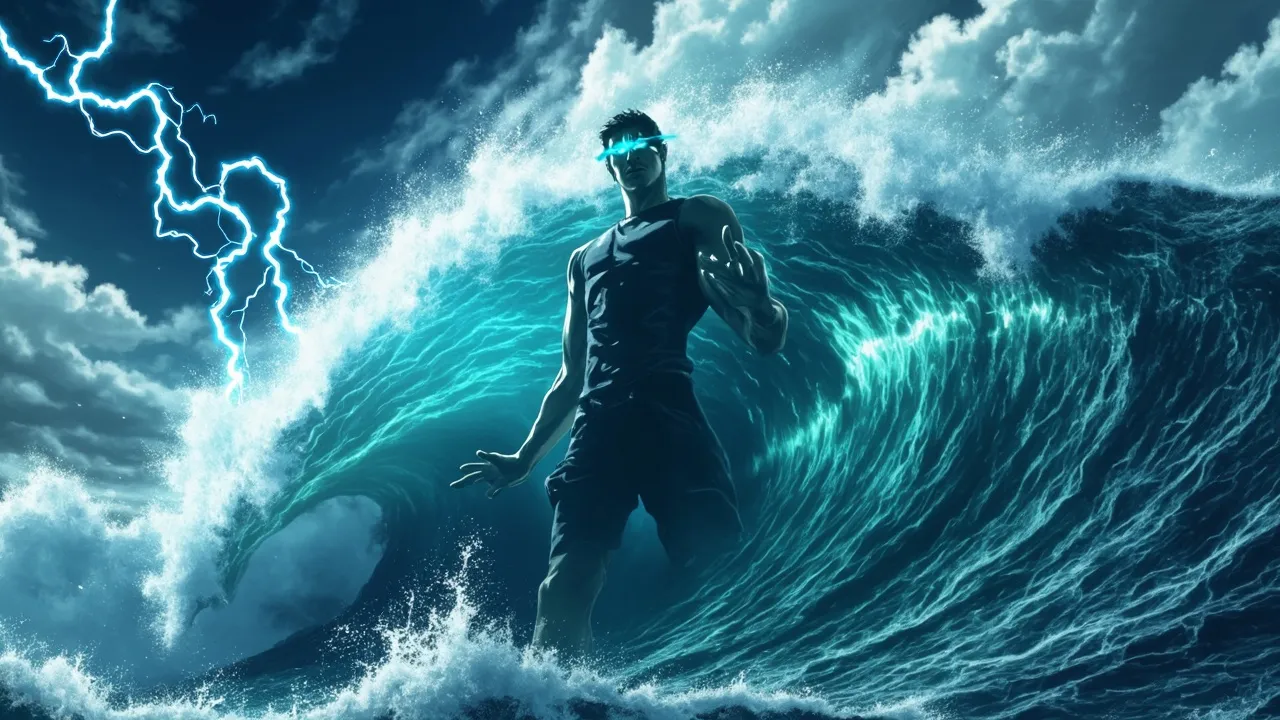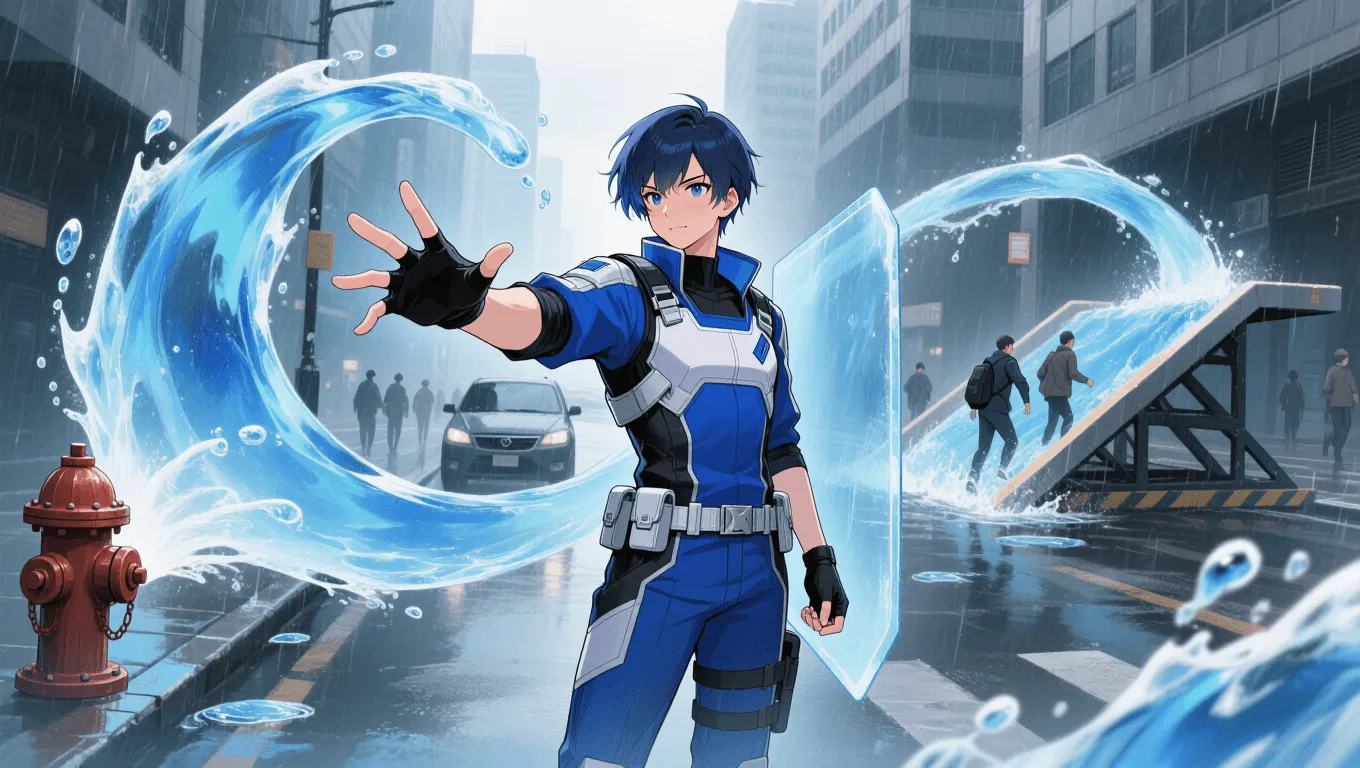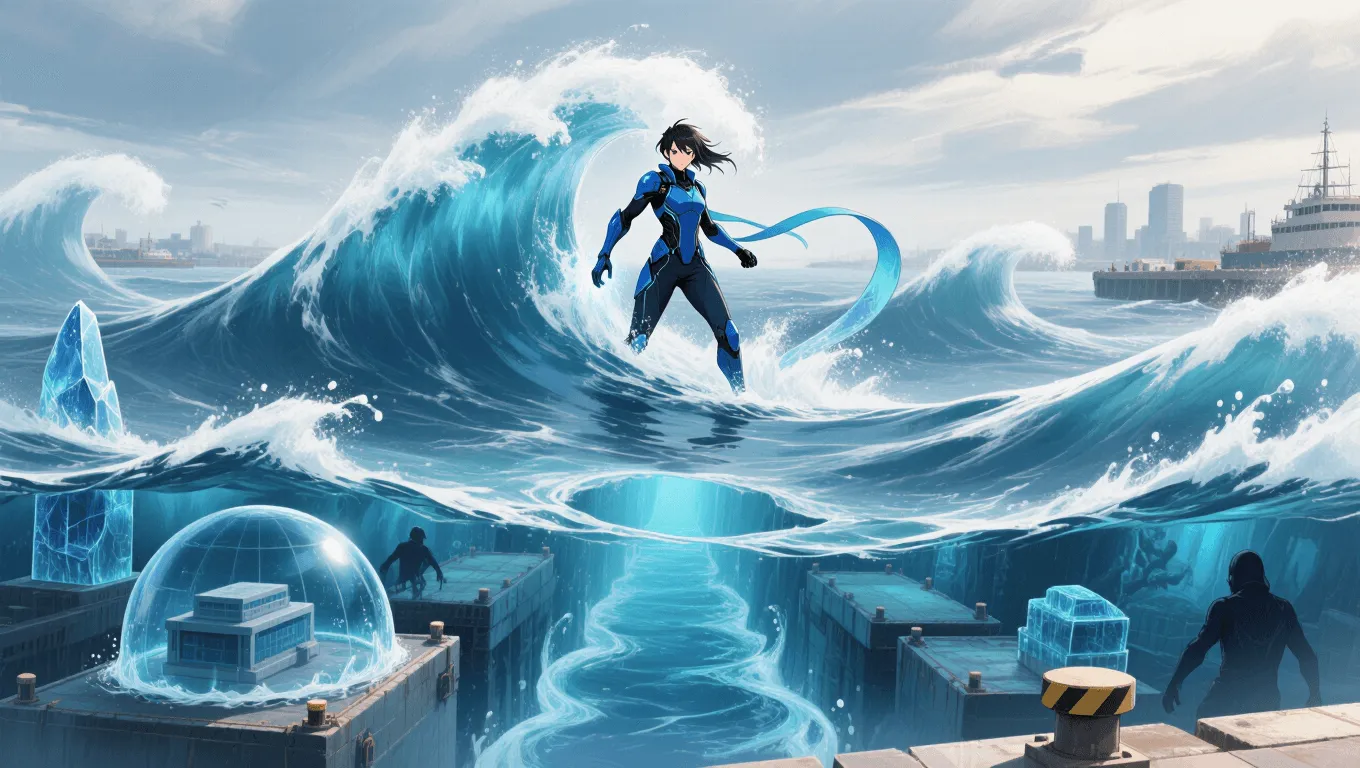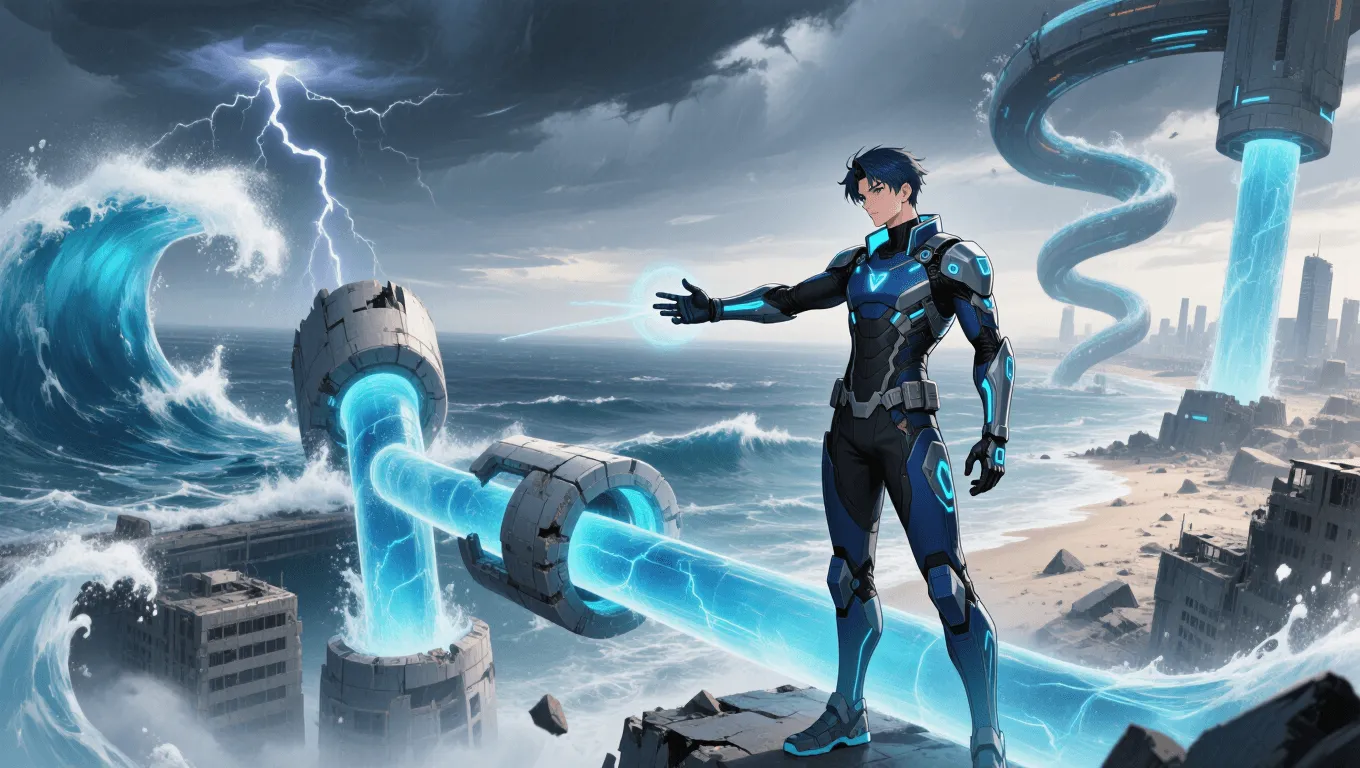Tidal Wave

Tidal Wave Video Demo 🎬
Table of Contents
What Is Tidal Wave
Tidal Wave is a hydrodynamic superpower focused on large-scale water manipulation, enabling the user to generate, shape, and propel massive waves for offense, defense, and mobility. Unlike general hydrokinesis or aquakinesis, Tidal Wave emphasizes macro-level wave generation—tsunamis, surges, and wall-like breakers—while still drawing on fine control of pressure, current, and flow. Practitioners create kinetic waterfronts that slam through terrain, overwhelm fortifications, and reshape battlefields. This power also extends to steering existing bodies of water, amplifying natural tides, and converting environmental moisture into coherent waveforms.
Fans and worldbuilders often group Tidal Wave under the broader family of water manipulation powers in our superpower wiki. If you’re brainstorming character concepts, you can roll the dice with our random superpower generator to discover complementary abilities.
Core abilities of Tidal Wave
Macro-Scale Wave Generation
The signature capability is summoning large waves—from street-flooding surges to city-threatening tsunamis. Users draw water from oceans, lakes, rivers, storm systems, underground aquifers, or atmospheric humidity, then compress and release it in a coherent crest. Advanced users can pre-shape the waveform, adding steep faces for impact or long, rolling swells for displacement.
Flow and Pressure Control
Beyond raw volume, precise control of pressure and velocity determines real effectiveness. Micro-adjustments along the wave face let users harden sections into battering rams, soften others to cradle allies, or carve channels through debris. Pressure shearing can strip weapons from opponents or scour contaminants from terrain.
Directional Steering and Current Sculpting
The user can bend currents mid-surge—hooking a wave around corners, up stairwells, or through alleyways without losing cohesion. Current sculpting also enables “split-crest” maneuvers: a wave divides to flank targets, then recombines behind them to trap or sweep away foes.
Hydrodynamic Constructs
By thickening and reinforcing water with sustained pressure, practitioners form constructs such as water walls, domes, ramps, and catch basins. These behave like flexible shields or terrain features, useful for crowd control, evacuation corridors, or firebreaks.
Environmental Amplification
Tidal Wave synergizes with weather and lunar conditions. Storm fronts, heavy rainfall, king tides, and glacier melt can be harnessed to multiply volume and reach. With training, some users can resonate with tidal cycles to time strikes for maximum amplitude.
Mobility and Transport
Riding a self-generated breaker enables rapid traversal over water or flooded urban landscapes. Users also craft moving platforms—flat crests that carry allies, vehicles, or cargo. In rescue scenarios, low-impact swells can ferry civilians to safety.
Sensory Feedback (Hydro-Sense)
Advanced users read minute changes in pressure, temperature, and salinity through their waves. This “hydro-sense” detects submerged hazards, cloaked enemies, structural weaknesses, or the best breach points in sea walls and barriers.
Application / Tactical Advantages in Combat
Area Denial and Battlefield Control
A single well-placed surge can deny enemy advances, isolate squads, or funnel threats into chokepoints. Collapsible water walls create temporary fortifications, while rolling swells can keep foes off-balance without causing permanent harm—ideal for capture missions.
Breach and Break
Concentrated wave faces act like moving rams, cracking doors, vehicles, and brittle terrain. By phasing water into seams and then expanding it with pressure, users can pop open hatches, unseat anchors, or disable mechs without explosives.
Crowd Safety and Non-Lethal Options
Soft-crest waves can separate combatants and clear civilians from danger zones. Cushioning eddies prevent fall injuries during evacuations. Controlled drainage reduces flood risk post-engagement.
Environmental Counter-Measures
Water excels at quenching flames, dispersing gas clouds, cooling overheated machinery, and washing away corrosives. A Tidal Wave user can neutralize incendiaries, disrupt chemical hazards, or dampen explosive shockwaves.
Disruption of Ranged and Aerial Threats
Sheets of water refract light and absorb kinetic energy, degrading precision fire. Downdrafts from aircraft meet rising spray and turbulence, compromising airborne stability. Combined with high-spray mist, users can blind sensors and jam LIDAR.
Shock and Awe
The psychological impact of a cresting wall of water cannot be overstated. Enemies often break ranks or retreat preemptively, turning battles without heavy casualties.
Level: Level 1 🏙️, Level 2 🌇, Level 3 🌃
Level 1 — Wave Initiate
At entry level, the user manipulates moderate volumes: hydrant bursts, canal flows, or street-wide surges. They can:
-
Raise chest-high breakers for crowd control.
-
Form simple shields, ramps, and cushions.
-
Redirect small rivers or drainage systems to protect flanks.
-
Maintain line-of-sight steering for short distances.

Tactical snapshot: Ideal for rescue, riot control, and quick breaches. Limited endurance and range; requires nearby water sources or high humidity.
Level 2 — Tidecaller
Mid-tier practitioners scale up to harbor-sized waves and complex shaping. They can:
-
Generate multi-block surges with variable crest hardness.
-
Split waves for flanking maneuvers and recombine under pressure.
-
Maintain hydrodynamic constructs (domes, trenches) for minutes.
-
Surf fast-moving crests for rapid transport and precision insertions.
-
Employ hydro-sense to probe submerged threats and weak points.

Tactical snapshot: Strong battlefield shaper with reliable crowd protection and infrastructure control. Risk of collateral flooding increases if drainage isn’t managed.
Level 3 — Tsunami Architect
At apex mastery, users command city-scale water bodies and synchronize with tides and storms. They can:
-
Summon or redirect tsunamis across kilometers with fine-grained steering.
-
Layer waves—staggered, braided, or helical—to bypass defenses.
-
Create semi-stable, pressure-reinforced “liquid concrete” structures.
-
Integrate advanced hydro-sense for real-time terrain mapping.
-
Execute precision extractions, using narrow tunnels through moving masses of water.

Tactical snapshot: Strategic force capable of reshaping coastlines and turning weather into a weapon. Requires discipline, ethical constraints, and detailed evacuation planning.
Limitations of using the Tidal Wave
-
Source Dependency: While humidity and ice can be converted, the power performs best with large accessible water sources. Arid environments drastically reduce potential.
-
Collateral Flooding: Unmanaged backflow, debris transport, and sewer overflow can cause secondary damage. Responsible users plan drainage paths and deploy catch basins.
-
Structural Sensitivity: Old or compromised infrastructure may collapse when subjected to pressure waves. Precision reduces harm but requires concentration.
-
Endurance and Focus: Sustaining macro-scale waves taxes stamina and mental focus. Long campaigns demand rotation, hydration, and rest cycles.
-
Visibility and Line of Effect: Dense urban layouts, cliffs, or underground settings may limit steering options, forcing shorter or segmented surges.
-
Electro-Hazard: Electricity within water poses risk to the user and allies; wave routes must avoid live grids or be insulated via pressure-shell techniques.
-
Miscalculation Risk: Over-hardened crests or abrupt directional changes can produce dangerous undertows. Precision training mitigates unintended casualties.
Weakness against what other superpowers
-
Cryokinesis / Ice Manipulation: Freezes waves mid-crest, locking motion, splitting flows, or turning them into brittle structures that can shatter.
-
Terrakinesis / Earth Manipulation: Rapid berms, trenches, and absorbent barriers drain or redirect surges; landslides can also block channels.
-
Aerokinesis / Wind Manipulation: High crosswinds shear crests, flatten breakers, or vaporize spray, reducing momentum and accuracy.
-
Electrokinesis / Lightning Projection: Conductive water endangers operators and escorted allies; targeted strikes can force disengagement.
-
Thermokinesis / Heat Manipulation: Superheating creates steam bursts that disrupt cohesion and impair visibility.
-
Gravity Manipulation: Localized gravity wells pin waves in place or drain them into depressions; variable gravity distorts flow patterns.
-
Vacuum or Pressure Nullification: Cancels the pressure gradients that hold a wave together, causing collapse before impact.
-
Molecular Adhesion / Friction Control: Makes surfaces hydrophobic or super-absorbent, ruining traction and draining force.
Synergistic Power Combos
-
Weather Control / Storm Manipulation: Rainfall expands supply; wind fields and barometric shifts pre-shape waves. Together, these powers deliver precision tsunamis and rapid flood suppression.
-
Lunar or Tidal Influence: Timing attacks with lunar phases amplifies crests naturally, conserving energy and extending range.
-
Cryokinesis (Allied): Freezing the base of a wave turns it into an armored battering ram; post-impact thaw enables safe drainage.
-
Sound / Vibration Control: Sonic pulses can destabilize enemy formations moments before a surge or break debris clumps safely.
-
Plant Manipulation: Root networks reinforce riverbanks and guide flow; aquatic flora can filter contaminants in cleanup.
-
Light and Illusion Crafting: Refracted light through spray provides camouflage, decoys, or dazzling glare during boarding actions.
-
Geo-Engineering Constructs: With allied earth manipulators, users carve spillways, reservoirs, and sluices on the fly for flood-safe engagements.
-
Healing / Biokinesis: Post-operation medical support mitigates hypothermia and water-impact trauma among civilians and allies.
Known Users
Writers and gamers often model Tidal Wave users after iconic aquatic characters who showcase water manipulation at scale.
-
Aquaman (DC Comics): Frequently depicted controlling oceans and marine dynamics; while his powers vary by era, many portrayals include large-scale hydrodynamic feats. Learn more about Aquaman.
-
Mera (DC Comics): Known for hard-water constructs and wave shaping, often creating domes, blades, and surges during Atlantean conflicts.
-
Namor the Sub-Mariner (Marvel Comics): A ruler of Atlantis with command over sea warfare and environmental water tactics.
-
Aqualad / Kaldur’ahm (DC Comics): Uses hard-water weapons and controlled swells for mobility and defense.
-
Hydro-Man (Marvel Comics): Presents an extreme version of fluid control and body-to-water transformation, sometimes raising towering surges.
For more powers adjacent to this theme—like hydrokinesis, weather control, or cryokinesis—browse the full index on our superpower wiki, or discover unexpected combinations with the random superpower generator.
